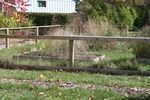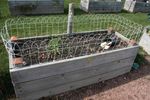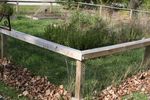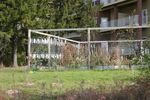Wildlife in You r Yard and Garden - Wisconsin Humane Society
←
→
Page content transcription
If your browser does not render page correctly, please read the page content below
Wildlife in Your Yard and Garden Critter
Ridder® is a
non-toxic,
easy to apply,
pepper-
based,
granular
repellent
Situation: Animals are getting into my garden and eating my plants and flowers!
Why This Happens: Gardens are full of delicious food for all types of wildlife. When animals “raid” a Liquid
vegetable garden or dig up a flower bulb, they don’t know they are “trespassing” or “stealing,” and they are Fence® can
not deliberately doing this to frustrate you or try to drive you crazy! They are simply utilizing the resources in help protect
their environment in order to survive.
plants from
FAQs and Humane Solutions: damage by
deer, rabbits,
“Animals are getting into my garden and eating my plants and flowers, what can I do to stop and
them?” woodchucks
Tolerance – Any time wildlife and people share living space there are going to be conflicts over resources to
varying degrees. It is unrealistic to expect that wildlife must never have any effect on your garden and
landscaping. So, if the damage caused by animals is occasional and slight – a nibble here and a nibble there
The
--you may not need to do anything. That being said, the best time to take action to suppress or even stop
more serious landscape damage is when it first appears. It is easier to stop further damage when the ScareCrow®
animals are in an exploratory stage, for example, you just notice that deer are beginning to browse on your frightens
shrubs in early winter, or spring seedlings are just coming up in your vegetable garden and you’ve noticed animals with a
the tender new plants are being nibbled on. blast of water
when they trip
Scare Tactics – It is often possible to temporarily frighten animals away from plants you are trying to its motion
protect, especially when there is other “natural” food available for the animals and they haven’t already detector
gotten into the habit of dining on the plants you’re trying to protect.
Animals can quickly become accustomed to some scare tactics, especially if the scare tactics are continuous
or if the “scary” tactic doesn’t move or change positions over time. For example, the plastic owls and fake
snakes sold for this purpose may work for a day or two, but when the animals get the idea that these figures Irri-tape®
don’t move at all, they’ll no longer be frightened by them. See the accompanying photos for examples of
is an
some scare tactics that can be effective. We recommend and sell both the ScareCrow, motion-activated
sprayer, and Irri-tape, iridescent Mylar ribbon. iridescent
plastic
Repellents – These are products can be effective in reducing damage when they are sprayed on individual ribbon that
plants or small groups of plants, especially when there is other food available to animals and they have not shimmers
already established a habit of feeding on the plants you are trying to protect. Repellents are NOT effective at and flutters
keeping animals away from an entire garden or out of your yard. in the windFencing – For many species, the most effective, long-term solution is to install fencing around your garden. Hardware
Some gardeners make fencing panel frames using 2” x 2” lumber and staple chicken wire or other similar cloth for
fencing to the outside of these panels. With vertical stakes for support, the panels are wired or cable-tied
fencing or
together end-to-end to make a fence. These panels can be put up when they are needed, such as in the
early spring, and taken down and stacked out of the way when they are not needed animal
exclusion is
Rabbits - A two foot high fence will keep rabbits out. Use chicken-wire or fencing with 1” x 1” or 1” x available at
2” or smaller mesh. Planting in raised garden beds can also effectively exclude rabbits (see photos). any
Make sure that fencing is installed tight to the ground to prevent rabbits from slipping under the hardware
fence. store
Woodchucks - The fence should be 4 feet high and be buried 12 or more inches below ground. Use
mesh that is no larger than 3” x 3” (using smaller mesh that is smaller than this will help keep
rabbits out, too). Woodchucks are great diggers, so ideally, the bottom of the fence will be bent or
joined with another piece of fencing at 90-degrees outward in an “L”. The bottom of the “L” should
be 12 to 24 inches wide. This will discourage animals from digging under the fence. See the
diagram below. Woodchucks are good climbers, so you may need to flare the top 1 or 2 feet of the
fence outward at a 45-degree angle to prevent them from going over the fence. Or instead of flaring
the fence outward as described, reportedly, leaving the top 1 or two feet of the fence unsupported by
fence posts will make a woodchuck feel insecure about climbing on this “floppy” portion of fence.
Squirrels and Chipmunks – These nimble animals are excellent climbers, so fencing is very unlikely to
provide much of a deterrent.
Deer – A four-foot high fence around small garden plots can discourage deer from casually browsing
on garden plants when other “natural” foods are available to the deer. For larger plots and for times
when natural food is not abundant (i.e. winter and early spring) the fence will need to be at least six
feet high. When natural foods are very scarce, deer have been known to leap over eight-foot high
fences to get to food!
Raised garden beds like these will keep
“Are there any types of plants that deer, rabbits, and woodchucks do not like?” rabbits out. The bed below uses an arch
of hardware cloth over the top to protect
No plant should be considered to be 100% deer- or rabbit-proof. However, there are a number of plants that tender plants from deer
have track-records of being deer- and/or rabbit-resistant under most conditions. We suggest that you check
with a local, experienced horticulturalist, Master Gardener, or experienced garden center staff for a list of
plants (ideally native Wisconsin plants) they recommend for your area.
“I just laid some sod and animals are pulling the sod back at night!” Why are they doing this and
how can I stop them?”
Raccoons or skunks are pulling the sod up to get to the tasty grubs and worms that like to live under the
watered sod. The animals typically stop this behavior once you stop watering. But to get them to stop this
behavior, you can try not watering the sod at night, when these animals are active, and instead set up a
ScareCrow motion-detector sprayer to frighten the animals away with a blast of high-pressure water.
Other methods to try are to sprinkle Critter Ridder® granules around the new sod, but outside of
the area you are watering (water will wash away the repellent). Another good method is to temporarily
cover the sodded area with overlapping strips of chicken-wire mesh. The perimeter and overlapping areas of
the mesh should be held down with bricks or rocks, or staked down with landscape staples.“How can I keep skunks and raccoons from digging holes in my lawn?”
Skunks and raccoons may dig small divots in your lawn when they forage for grubs and worms. The
grubs can kill your grass/sod by eating the roots of the grass, so the skunks or raccoons are actually
doing you a favor by consuming these pests. Just repair the divots by tamping them down with your
foot.
But if you really can’t tolerate the after-effect of the animals’ foraging activities, a short-term
solution to keep the raccoons and skunks away is to use The ScareCrow, motion sensor sprayer. The
ScareCrow will give an animal a harmless, but frightening, blast of water when they walk into the
sprayer’s motion-sensor field. Or, you could try sprinkling Critter Ridder pepper-based non-toxic
repellent around or on small areas to temporarily keep the animals away.
A longer-term solution would be to treat your lawn for grubs. “Beneficial nematodes” are
organisms that can be purchased at a garden store or over the Internet. Once introduced to your lawn,
over time, the nematodes can control the grubs, thus removing the incentive for skunks and raccoons
to dig in your lawn.
We recommend that you consult with an experienced Master Gardener or horticulturalist in your
area for information about treating your lawn for grubs.
A ring of hardware cloth
stapled to a stake driven
into the ground can protect
shrubs and small trees
from rabbits and deer
damage.
A ribbon of Irri-tape attached to 6”- 8” -high Irri-tape, cut into strips
stakes in or around the garden may help and stapled to stakes so
keep animals away. they flutter in the breeze,
can help deter animals.This garden is protected using chicken wire framed with 2”x4”s attached to 4”x4” posts. The height is 4 feet, enough to keep cottontails out and to stop casual foraging by deer. 2”x4” wire screening attached to metal posts. This 3 foot tall This sturdy 6-foot high fence provides great protection for this fence will discourage casual foraging by deer. To keep rabbits garden out, use smaller-mesh fencing
Hardware cloth Plastic tubing
covering the used to
soil in a flower protect the
pot. This will trunk of a
help keep small tree
chipmunks and from damage
squirrels from by rabbits.
digging in the Ideally, the
soil. On a tube should be
larger scale, 3 feet higher
this method than the
also works to deepest
protect buried expected snow
bulbs before level.
they sprout.
©Wisconsin Humane Society, 2013
The Wisconsin Humane Society is a charitable organization that depends entirely on donations to fulfill its mission to create a community that values animals and treats them
with respect and kindness. Your support for the WHS Wildlife Rehabilitation center makes possible the distribution of information like this to thousands of people who request it
each year, and makes possible the humane care of over 5,000 injured, sick, and orphaned wild animals from our community each year. You may donate online at
www.wihumane.org/donate or by mailing a check to the following address: WHS Wildlife Center, 4500 W. Wisconsin Avenue, Milwaukee, WI 53208You can also read



























































